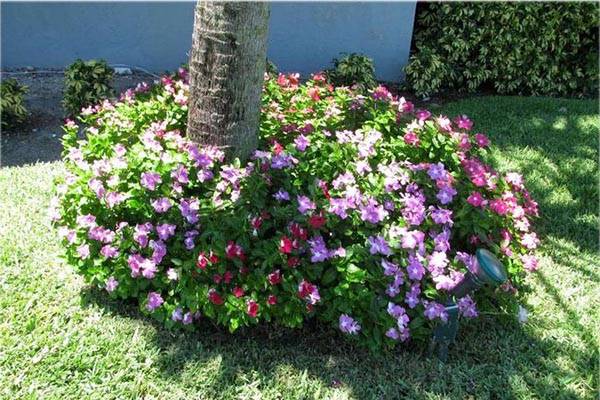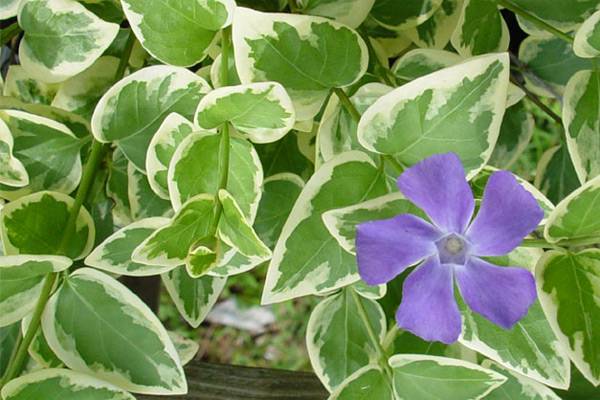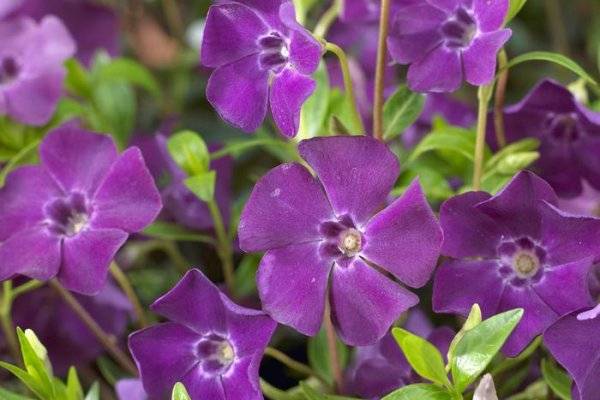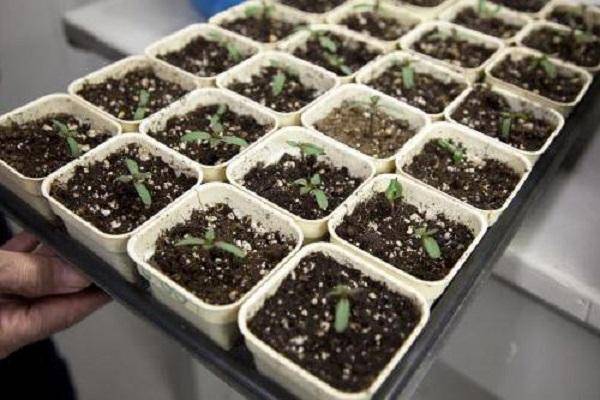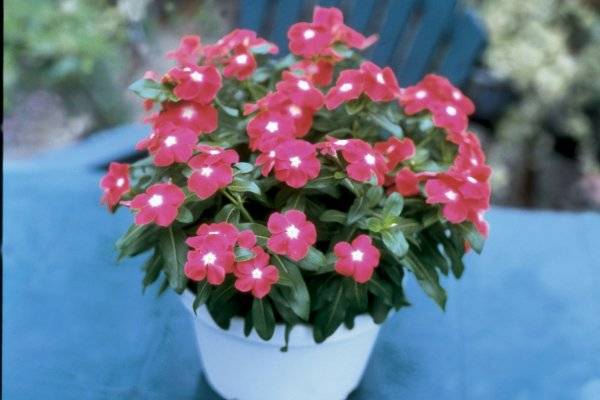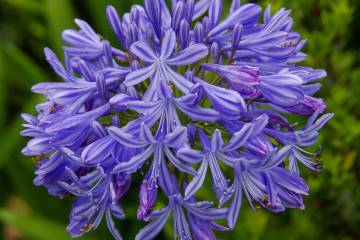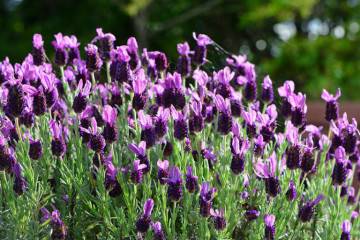Periwinkle - planting and care in the open field
Content:
Periwinkle is a flower that belongs to shrubby ground cover plants widely used in landscape design. It does not cause problems with growing, even beginners in gardening can do this.
Description of periwinkle: varieties and varieties
Periwinkle is a plant that surprises with its features. It is a long-lived shrub with dense glossy foliage covered with a waxy bloom. Inflorescences are distinguished by pale purple, pale blue, pinkish colors, each flower has 5 petals.
In nature, there are a small number of varieties of culture, but thanks to the work of breeders, various variations with different colors of the petals have been bred.
Large periwinkle (Vinca Major) has large buds and foliage, blooms twice a year - on May and September days. The average size of Alba bushes (Alba) is up to 25 cm. Designers are especially fond of species with yellowish-whitish foliage streaks (Reticulata and Variegata).
Herbaceous periwinkle (Vinca herbacea) is not suitable for cold regions due to its low frost resistance. May die in winter. It has ovoid leathery and small leaves with a rich green tint.
Pubescent (Vinca Pubescens) sheds foliage in winter, is frost-resistant. In extreme cold, the plant needs to be additionally covered. The flowers of the culture are small, they are located on shoots of medium height.
Small periwinkle (Vinca Minor) is a long-lived plant with ellipsoidal leather leaves. Easily withstands frosts with temperatures down to -10 ° C, but it is damaged only in severe frosts. The stems of a creeping plant are more than 100 cm long. It takes root at the end of the summer season, its flowers are small in size with a bluish tinge.
The lesser periwinkle has the following varieties:
- Alboplena. Differs in small flowers of snow-white color;
- Argenteo-variegata. The variety has large bright green foliage with creamy white blotches, bluish inflorescences;
- Atropurpurea. Has purple buds;
- Emily and Ralph Shugert. Known for their crisp white flowers;
- Bowles' Variety. It stands out for its long flowering period and rich blue buds.
Periwinkle: planting and care in the open field
Beautiful periwinkle grass does not have any special requirements for growing. Attention should be paid to the following points:
- on the ground. Fertile and humus soil is considered the best place to grow. The plant has no special requirements for the acidity of the soil; it feels fine on slightly alkaline and slightly acidic soils. The perennial periwinkle tolerates temporary heat and drought well, but it is better to maintain the substrate in a slightly moist state;
- to the location.The advantages of culture include its easy survival in areas that other horticultural crops deny. Variegated periwinkle can grow in constant shade, but bloom should not be expected. When planting in areas constantly lit by the sun, regular watering is required.
Seed planting
The seeds must be sown in pre-prepared containers to a depth of no more than 1 cm. The boxes are covered with a dense cloth that does not let in sunlight and sent to a room in which a constant temperature of about 23 ° C is maintained. After the first shoots appear, the pots are transferred to a cooler place with a temperature below 20 ° C.
Planting seedlings
Planting periwinkle in open ground is allowed after the end of the frost period and sufficient heating of the soil. You can plant seedlings from mid-May or early June, depending on the location of the region. Seedlings are sent to pre-prepared holes, located at a distance of 30 to 35 cm from each other. A gap of 10 cm is observed between the rows.
Watering and loosening the soil
Active watering is required only in the early stages of plant development, in the future it is carried out once a week or 10 days. Periwinkles are drought-resistant crops that have enough moisture in the soil.
Young shoots need protection only in the first years of wintering. For this period, they are reliably covered.
Loosening of the soil is carried out only when planting in clay soil and the absence of special leavening agents in it.
Reproduction methods
Perennials can reproduce in several ways:
- seed;
- cuttings;
- layering;
- dividing the mother bushes.
Experienced gardeners consider the last option the easiest. A small bush of culture quickly takes root in a new place and begins to grow evenly. Experts advise to carry out planting work in early spring or autumn. If planting is necessary on summer days, the ground is pre-moistened: under the mother plant and in the area of future planting.
Cutting of healthy branches follows the algorithm:
- Young shoots are cut.
- Rooted in prepared soil. A couple of leaves are left on the surface.
Timely watering will help the grass grow faster and cover the allotted area with an even carpet.
When propagating by layering, the healthiest shoots are added dropwise and await rooting. After the appearance of an independent root system, they are separated from the mother plants and transplanted to a new place.
Top dressing and transplanting
When planted in open ground, the plant does not need constant soil fertilization. Preference is given to urea (per 1 m² from 30 to 40 g of substance), humus and compost, they are introduced into the ground twice a year: during the flowering period in spring and at the end of September.
Pests and diseases
The culture refers to plants that are resistant to many diseases. Known grass pests and diseases:
- shield;
- aphid;
- powdery mildew;
- fungal infections.
To combat insect pests, an irrigation method is used with the help of a soap solution. Prevention of the appearance of a fungus is carried out by proper watering of shrubs, which react poorly to waterlogged soil.
Why doesn't the flower take root everywhere? It will not grow on swampy ground, the root system will quickly begin to rot and the plant will die.
Flowering period and care after
Periwinkle flowers appear in early June and persist until late autumn. Mass formation of buds is observed in the summer months.
How to prepare for wintering
Preparatory activities are associated with the following features:
- the culture easily survives the cold, but requires additional shelter with little snow and harsh winters;
- types with variegated leaves require annual shelter;
- species with pinkish buds in the open field cannot hibernate due to inability. They are planted at home;
- all young plants are covered with foliage or spruce branches in late autumn.
Use in landscape design
Decorative qualities and moderate requirements allowed the dwarf shrub to become a favorite flower for designers. The plant can be found in personal plots, in a city garden or park.
Mixing several types in one area helps to create a unique and colorful landscape. A uniform green blanket will hide the imperfections of the area, eliminate the need for planting additional flowers or shrubs.
Beneficial features
The culture is referred to as useful plants that are used in medicine and pharmacology.
The plant contains the following alkaloids, which are beneficial to the body:
- vinine and pubescin - glycosides responsible for lowering blood pressure;
- reserpine (only in rose buds) lowers blood pressure;
- rutin is essential for hypertensive patients.
In addition to alkaloids, the herb contains:
- vitamins, steroid and phenolic compounds;
- anthocyanins, vegetable sugar;
- mineral salts;
- tannins.
Culture-based drugs have properties that are used for therapy:
- cerebral circulation disorders;
- ischemia, osteochondrosis;
- psychosis, schizophrenia;
- atherosclerosis, depression;
- polyneuritis, autonomic neuroses;
- problems with coordination of movements of the consequences of meningoencephalitis;
- sensorineural hearing loss, ototoxic neuritis;
- vasomotor neuritis;
- atrophic forms of pharyngitis, laryngitis.
Blue and purple flowers can beautify any area. You do not need to take special care of the crop; it is suitable for growing by inexperienced gardeners. So that the personal plot does not look overgrown, it is necessary to limit the shrubs in growth within a certain territory, otherwise they will occupy all the free space.
